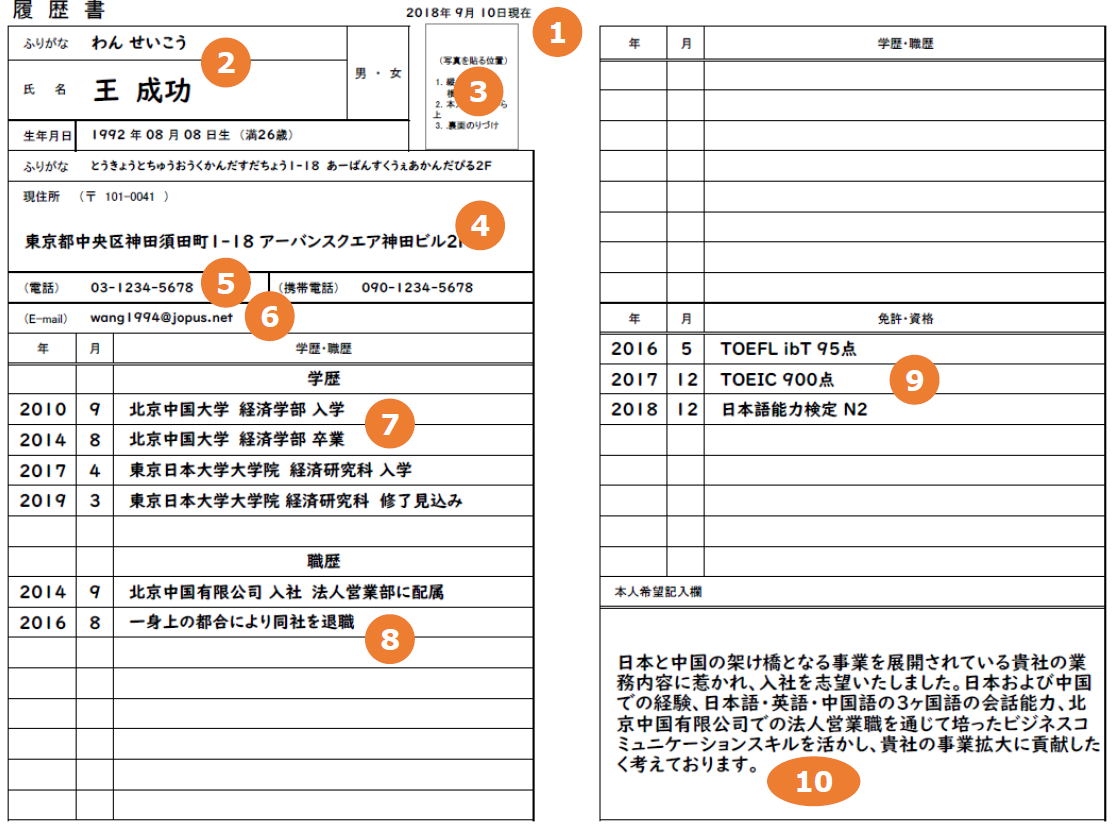A resume is one of the official documents you need to prepare when job hunting, and how you write it could largely affect the outcome. You have to prepare this document with the utmost care and attention especially when you’re applying for a company that attracts many applicants, because your resume often gets looked at closely in a thorough screening process before the company decides who to interview.
Here are some instructions how to write a good resume, which should give you a greater chance of getting selected.
The standard way of writing a resume
First of all, we will explain the standard way of writing a resume with this resume template.
 General resume format
General resume format1. Date
When you date your resume, the date should be the day you prepared it. If you are going to mail your resume, the date should be the day you send it.
2. Name
For the name field, write your full official name. On the first line at the top, if it says “ふりがな”, write your name in hiragana, or if it says “フリガナ”, write your name in katakana.
3. Profile photo
Generally, if possible, it is better to have a professional photo taken at a studio. If you can’t go to a studio, use a photo booth at the very least. Due to quality and stylistic issues, it is not advisable to use a photo taken with a smartphone. Wear a suit when taking the photo. You can change the brightness of the photo or other minor settings, but do not overly alter your photo.
A profile photo is an important part of your resume, as it delivers a first impression and influences the selection process. These things considered, make sure that you look cheerful and tidy in your photo. In addition to that, it is better to write your name on the back of your photo in case it comes off the resume in the mail.
4. Address
Write your current address in full; do not abbreviate it, and include your apartment name and room number.
5. Phone number
Write your current phone number. If you don’t have a home phone, just write your cell phone number.
6. Email address
Write your current email address. Be careful not to make any mistakes when doing this and write as neatly as possible, since you might be receiving an important email from the company that you’re applying for. Clearly indicate the difference between similar characters such as the letter “o” and the number “0”, as they could be hard to distinguish from one another.
7. Education history
Write your education history correctly, including that of your home country. If you’re still in school, write “卒業予定” or “卒業見込み” (expected to graduate).
8. Work history
Write your previous work history if you have worked before. Be careful not to mix up your education and work history on the form.
9. Qualifications and certificates
Write the names of qualifications and certifications you have attained, with the dates you received them. If you have any marketable skills or language certificates such as TOEIC, TOEFL and JLPT, make sure to put them down as they might make you stand out from the other applicants.
10. Requests
On Japanese resume forms, there is a section where you can write anything to do with work-related details. Do not leave this section blank and write something useful for the interview process. You can write the reasons for applying, your qualities, things you want to achieve at this company etc. If you have any requests about work location or working hours, remember to include that too.
Tips to write an attractive resume that gets you an interview
As we explained earlier, your resume is an important document that could significantly affect the screening step. If you want to write a resume that catches corporate recruiters’ eye and make them want to meet you, here are the three main tips to write an attractive resume.
- Write as neatly as possible, and avoid typographical errors.
- Get a good profile photo.
- Customize the request section depending on the company.
Write as neatly as possible, and avoid typographical errors
When writing your resume, pay attention to your handwriting and write as neatly as possible. If your handwriting is illegible, you may well have less chance getting selected. If you make typographical errors, corporate recruiters might assume that you would make such mistakes when you’re hired and required to submit an important document, or they might doubt your Japanese proficiency even when you note your language skills in your resume. To avoid any possible mistakes, you should prepare well before you write your resume by making a draft. When you finish writing your resume, check it carefully to see if you have made any typographical errors before submitting it.
Get a good profile photo
This is something we already pointed out, but the profile photo plays a big part in the resume screening process. This is the first thing corporate recruiters check when they see your resume. They try to read your personality or “aura” in your photo, which could significantly affect their decision. While you are not supposed to alter or composite your photo, it is important to get a photo that gives a bright and cheerful impression of you if possible.
Customize the request section depending on the company
When applying to multiple companies at the same time, you might tend to use the same expressions when filling out the resumes. One thing you can do to improve your chances of passing the screening process is to customize the message in the request section for each company rather than reusing the same phrases each time. This would show that you’re serious and make a good impression for each company.
However, your message should be specific and tailored-made for each company. Just looking at a company’s website and stating “the company’s corporate philosophy resonates with me” won’t convey your enthusiasm. Instead, learn deeply about the company and try to fill out the request section with a clear message stating what exactly attracts you to that particular company and why you want to work there.
Summary
Writing a good resume with no mistakes is key for successful job-hunting. Whilst following the instructions stated above, make sure you write each resume you plan to send out carefully.
Read articles of Job Hunting Guide for International Students
- Features of job-hunting in Japan
- Japanese hiring culture
- Job-hunting schedule in Japan
- The advantages and disadvantages of working at different types of companies
- Finding employment for international students
- Why do Japanese firms employ international students?
- Self-Analysis
- Industry research
- How to write a good resume
- Entry sheets
- Written exams
- Interview
- The steps for receiving a job offer and joining a company
- The procedure to change a visa status
- About job hunting after graduation














